12 Best Container Orchestration Tools for DevOps in 2025
Discover the 12 best container orchestration tools of 2025. A technical guide to Kubernetes, Nomad, and more to help you choose the right platform.

Containerization has fundamentally reshaped how modern applications are developed, deployed, and scaled. However, managing thousands of containers across complex, distributed environments presents a significant operational challenge. This is where the best container orchestration tools become indispensable, automating the deployment, management, scaling, and networking of containers to ensure resilience and efficiency. Selecting the right platform is a critical architectural decision that directly impacts your operational overhead, scalability, and development velocity. An incorrect choice can lead to vendor lock-in, technical debt, and an inability to meet performance demands.
This guide moves beyond surface-level comparisons to provide a technical, actionable analysis of the leading orchestration platforms. We dissect each tool's core architecture, specific use cases, and practical implementation hurdles. For startup CTOs, enterprise IT managers, and platform engineers, this resource offers a clear path to choosing a solution that aligns with your technical requirements and business objectives. We will explore managed Kubernetes services from major cloud providers, on-premises solutions like OpenShift, and versatile alternatives such as HashiCorp Nomad. Beyond the major cloud providers, various specialized implementations like Fabric Kubernetes offer unique approaches to managing containerized workloads. Each review includes direct links and detailed insights to help you make a well-informed decision.
1. Amazon Elastic Kubernetes Service (EKS) – AWS
Amazon Elastic Kubernetes Service (EKS) is a fully managed Kubernetes service that provides a hardened, upstream-compliant control plane. Its primary technical advantage is its deep integration with the AWS ecosystem. For example, it leverages AWS IAM roles for service accounts (IRSA) to provide granular, pod-level access to AWS APIs, eliminating the need for long-lived credentials. Networking is handled via the AWS VPC CNI plugin, which assigns a routable IP address from your VPC to each pod, simplifying network policies and enabling high-throughput, low-latency communication.
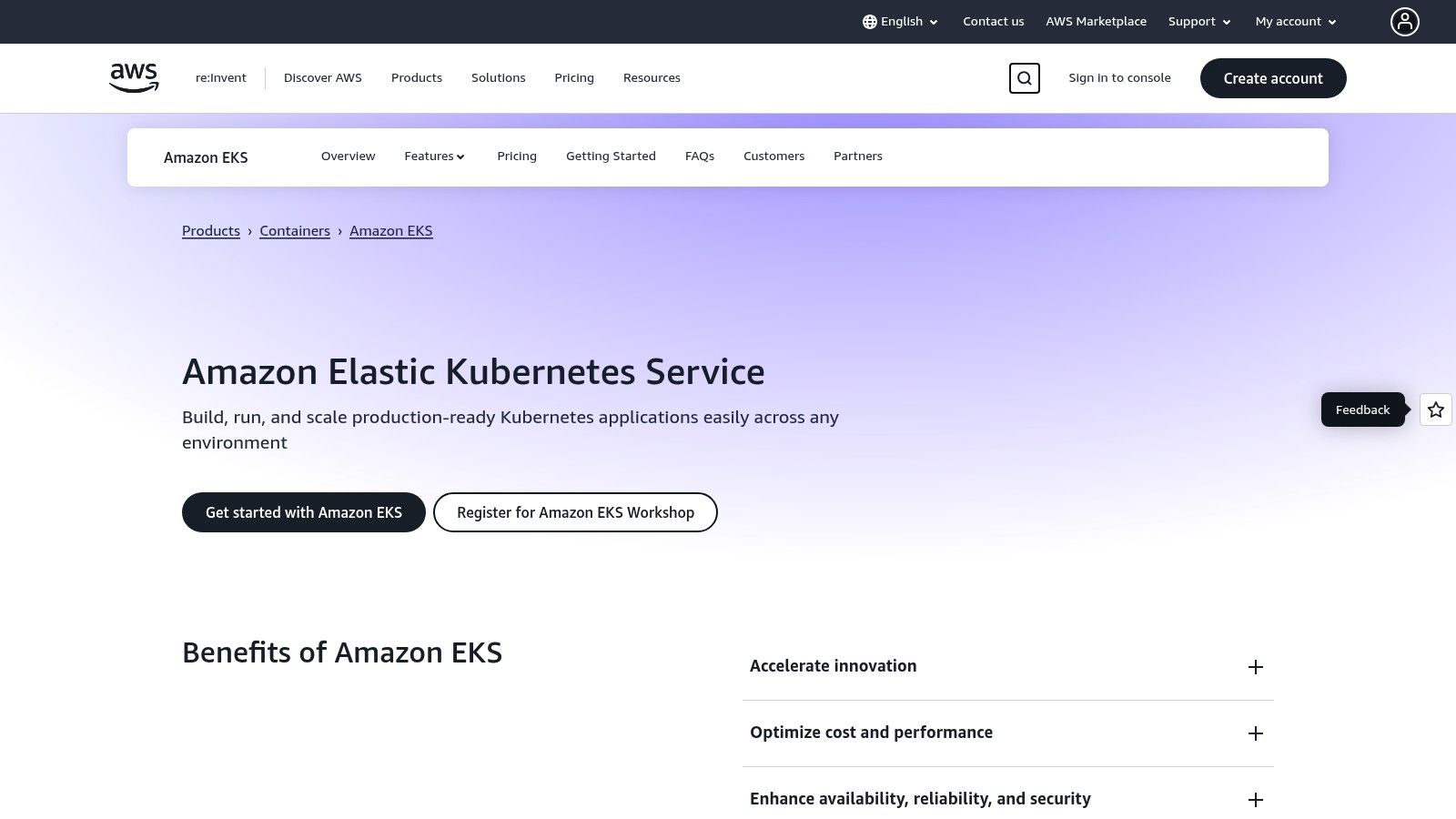
The platform is one of the best container orchestration tools for enterprises seeking high availability, as it automates multi-AZ control plane deployments, distributing API server and etcd nodes across three Availability Zones. A key differentiator is its support for multiple node types, including EC2 instances managed via EKS Managed Node Groups (which automate patching and upgrades) and serverless compute with AWS Fargate. While the cost model can be complex and debugging IAM/VPC CNI configurations has a steep learning curve, its robust security, compliance certifications (e.g., FedRAMP, HIPAA), and extensive marketplace make it a top-tier choice for production workloads. For a deeper technical dive, you can explore specialized EKS management services.
- Best For: Enterprises and startups deeply integrated with the AWS ecosystem requiring a managed, highly available Kubernetes control plane with fine-grained security controls.
- Key Feature: Native integration with AWS IAM for pod-level permissions (IRSA) and VPC for high-performance networking, plus support for EC2 and Fargate compute types.
- Pricing: Pay-as-you-go model for the control plane ($0.10 per hour per cluster) plus costs for worker nodes (EC2 or Fargate) and related AWS resources like ELBs and EBS volumes.
- Website: https://aws.amazon.com/eks
2. Google Kubernetes Engine (GKE) – Google Cloud
Google Kubernetes Engine (GKE) is a premier managed Kubernetes service that excels in operational automation and multi-cluster management. As the original creator of Kubernetes, Google's expertise is evident in GKE's design, which emphasizes stability and hands-off cluster operations. Its standout feature is the Autopilot mode, which abstracts the entire cluster infrastructure, managing nodes, scaling, and security configurations based on pod specifications. This allows teams to focus purely on deploying Kubernetes manifests (Deployment, StatefulSet), paying only for pod CPU, memory, and ephemeral storage requests, making it one of the best container orchestration tools for optimizing resource utilization and reducing operational overhead.
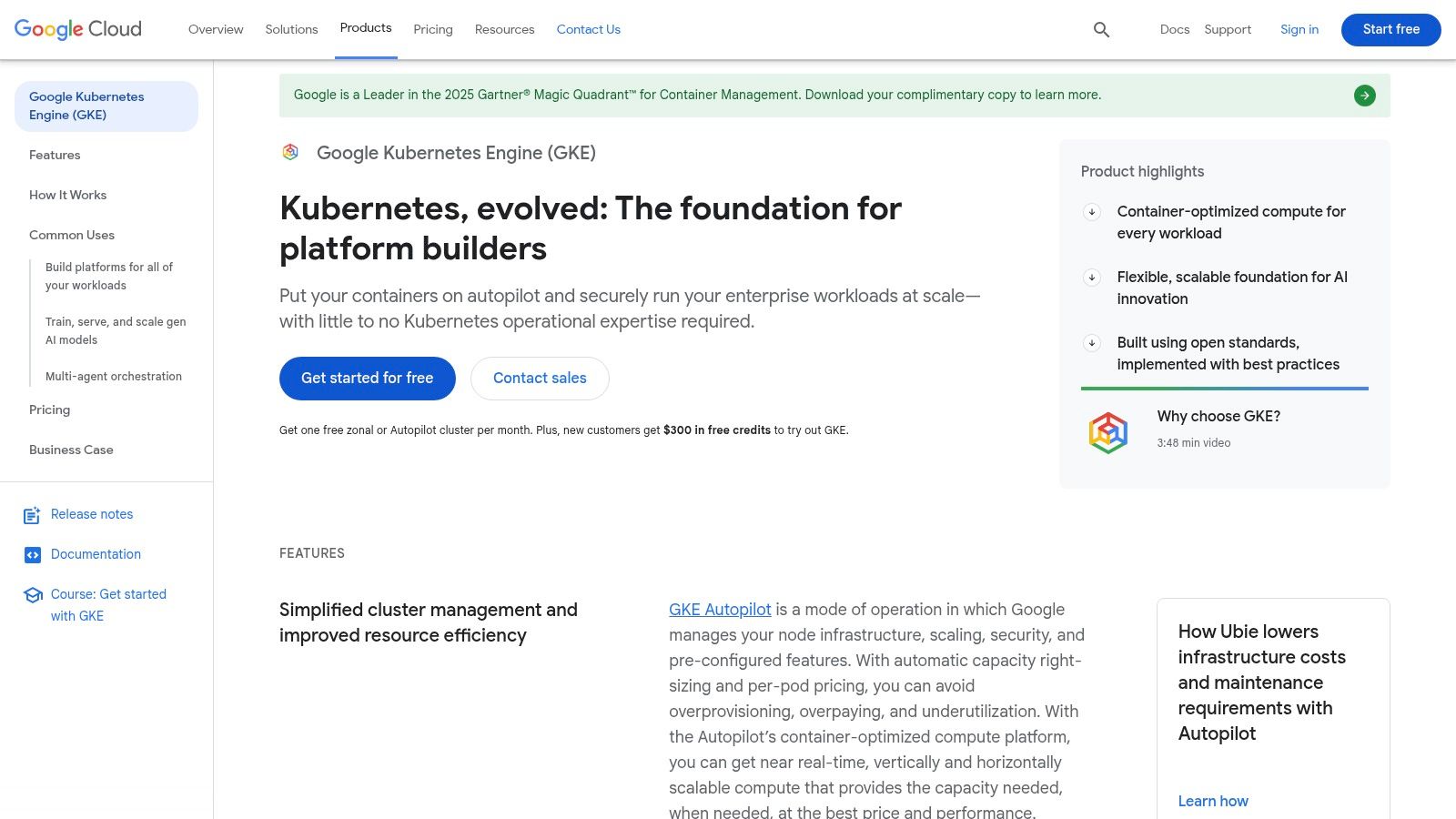
The platform’s technical strengths lie in its aggressive autoscaling capabilities (supporting vertical, horizontal, and multi-dimensional pod autoscaling) and strong SLAs, which extend to pod availability in Autopilot mode. GKE also integrates deeply with Google Cloud's ecosystem, offering advanced features like Fleet management (formerly Anthos) for unified multi-cluster configuration via a central Git repository and Workload Identity for secure, pod-level access to Google Cloud services. While regional cluster fees can add up and data-intensive workloads may incur significant networking costs, GKE's robust policy controls (via Policy Controller based on OPA Gatekeeper) and cost visibility make it a compelling choice for organizations prioritizing automation and governance. For teams assessing multi-cloud strategies, it's beneficial to compare GKE with other cloud provider offerings.
- Best For: Teams seeking maximum operational automation, cost optimization for variable workloads, and robust multi-cluster management capabilities through a GitOps model.
- Key Feature: Autopilot mode for fully automated node management and Fleet management for governing clusters as a unified group, with a single API endpoint.
- Pricing: Free tier for one zonal cluster. Standard mode: $0.10 per hour per cluster for the control plane. Autopilot mode: a per-pod vCPU, memory, and disk request fee, plus a base cluster management fee.
- Website: https://cloud.google.com/kubernetes-engine
3. Azure Kubernetes Service (AKS) – Microsoft Azure
Azure Kubernetes Service (AKS) is Microsoft's managed container orchestration service, distinguishing itself with first-class support for both Linux and Windows Server containers in the same cluster. This makes it an ideal choice for organizations with mixed-OS environments or those containerizing legacy .NET Framework applications. AKS simplifies Kubernetes management by offloading the operational overhead of the control plane, offering automated upgrades, patching, and scaling. Its deep integration with the Azure ecosystem, including Azure Active Directory for Kubernetes RBAC and Azure Monitor for observability, provides a seamless experience for teams already invested in Microsoft's cloud.
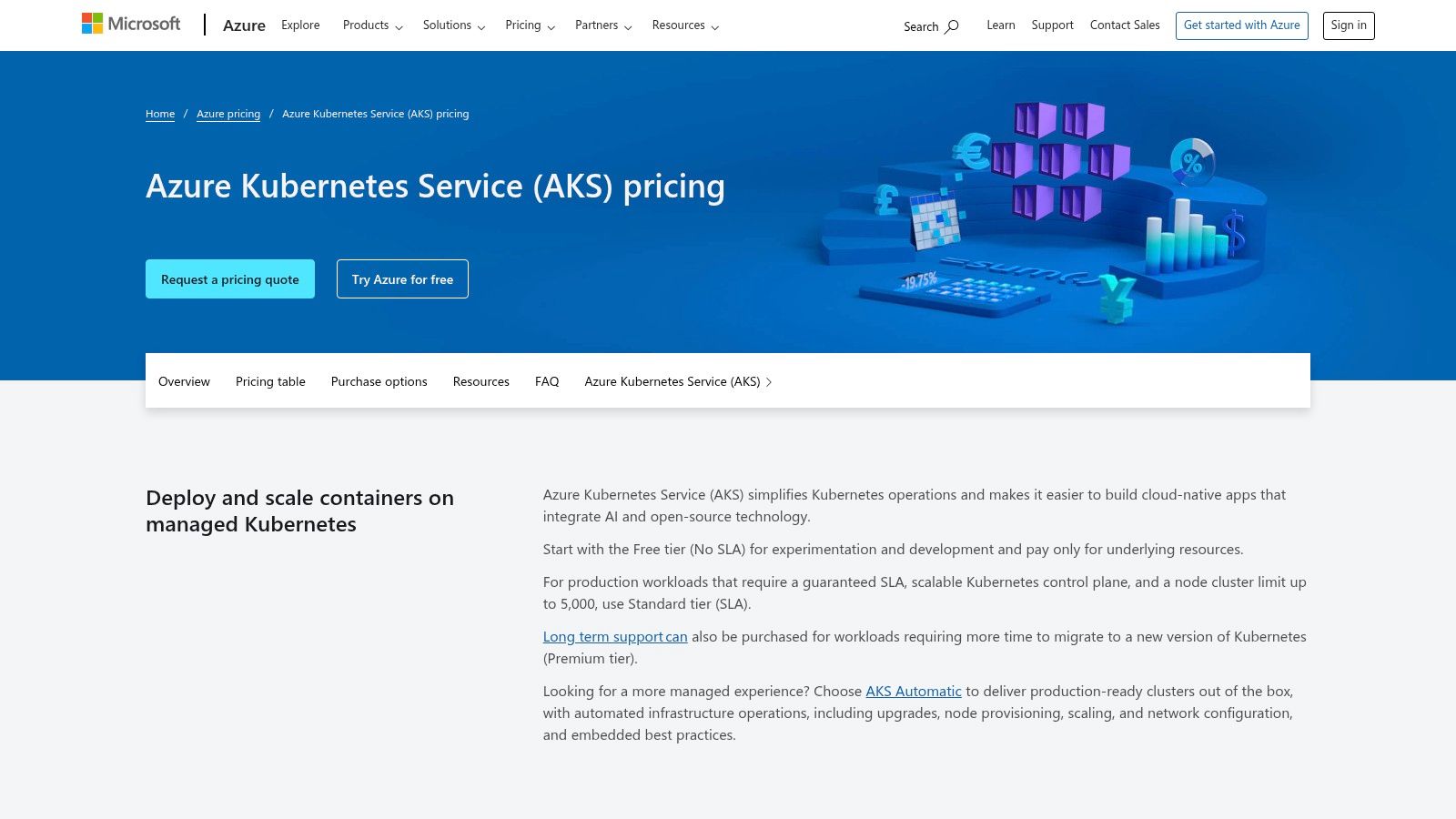
Technically, AKS stands out as one of the best container orchestration tools due to its flexible tiering system, including a Free tier for development and a Standard tier that guarantees a 99.9% uptime SLA for the Kubernetes API server. It offers a choice of networking plugins, including Kubenet for basic networking and Azure CNI for direct VNet integration, giving pods full network identity. For hybrid deployments, AKS can be extended to on-premises environments using Azure Arc, allowing for consistent GitOps-based configuration management across cloud and edge locations. Its native integration with tools like GitHub Actions and Azure DevOps streamlines CI/CD pipelines, offering a powerful, enterprise-grade platform that scales up to 5,000 nodes per cluster.
- Best For: Enterprises with a significant Microsoft footprint, especially those running Windows Server containers or leveraging Azure DevOps and Azure Active Directory for unified identity management.
- Key Feature: Native support for Windows Server node pools and deep integration with Azure security and identity services like Azure Active Directory and Microsoft Defender for Containers.
- Pricing: The Free tier has no control plane management fee. The Standard tier costs $0.10 per cluster per hour, with worker node and resource costs billed separately. An Uptime SLA is available as a paid add-on.
- Website: https://azure.microsoft.com/en/products/kubernetes-service
4. Red Hat OpenShift
Red Hat OpenShift is an enterprise-grade Kubernetes distribution designed to provide a consistent application development and deployment experience across any infrastructure. It bundles a hardened, opinionated version of Kubernetes with a suite of integrated tools and workflows, significantly accelerating developer productivity. The platform offers a unified solution with built-in CI/CD pipelines (OpenShift Pipelines, based on Tekton), service mesh (OpenShift Service Mesh, based on Istio), serverless capabilities (OpenShift Serverless, based on Knative), and advanced security features, abstracting away much of the underlying infrastructural complexity.
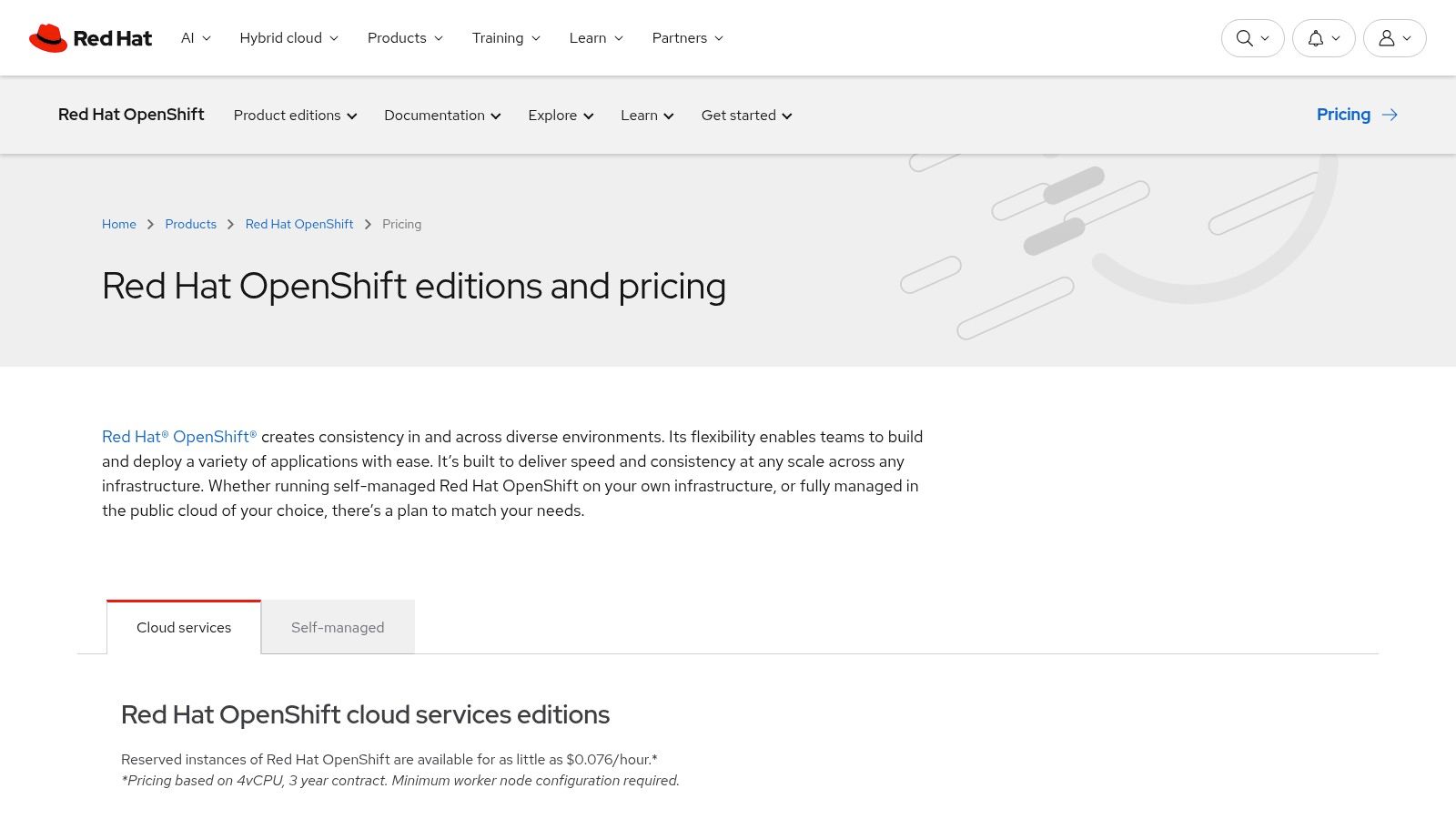
OpenShift excels in highly regulated industries due to its robust, multi-year enterprise support and hardened security posture, leveraging SELinux and strict Security Context Constraints (SCCs) by default. A key differentiator is its mature Operator ecosystem via the OperatorHub, which automates the lifecycle management of complex stateful applications like databases and message queues. While its comprehensive, all-in-one nature introduces higher resource overhead and complexity compared to vanilla Kubernetes, it is one of the best container orchestration tools for large organizations needing a turnkey, production-ready platform that works consistently on-premises (on bare metal or vSphere) and across major public clouds. Navigating its extensive capabilities often benefits from expert guidance, and you can explore specialized consulting for OpenShift and Kubernetes.
- Best For: Large enterprises requiring a fully-supported, secure, and consistent Kubernetes platform across hybrid and multi-cloud environments, with a focus on developer self-service.
- Key Feature: An all-in-one, opinionated platform with integrated developer tools (source-to-image builds, CI/CD) and a mature Operator framework for application lifecycle management.
- Pricing: Varies significantly based on deployment model (self-managed vs. managed on AWS, Azure, etc.) and support level; typically involves subscription-based licensing per vCPU or core.
- Website: https://www.redhat.com/en/technologies/cloud-computing/openshift/pricing
5. SUSE Rancher (Rancher Prime)
SUSE Rancher is a powerful, open-source multi-cluster Kubernetes management platform designed to simplify operations across any CNCF-certified Kubernetes distribution. Its core strength lies in providing a unified control plane for managing heterogeneous clusters, whether they are on-premises (RKE/RKE2), in the cloud (EKS, AKS, GKE), or at the edge with its lightweight K3s distribution. This centralized approach streamlines everything from cluster provisioning and lifecycle management to enforcing consistent security policies (via OPA Gatekeeper integration) and role-based access control (RBAC) across your entire containerized infrastructure, making it one of the best container orchestration tools for hybrid and multi-cloud environments.
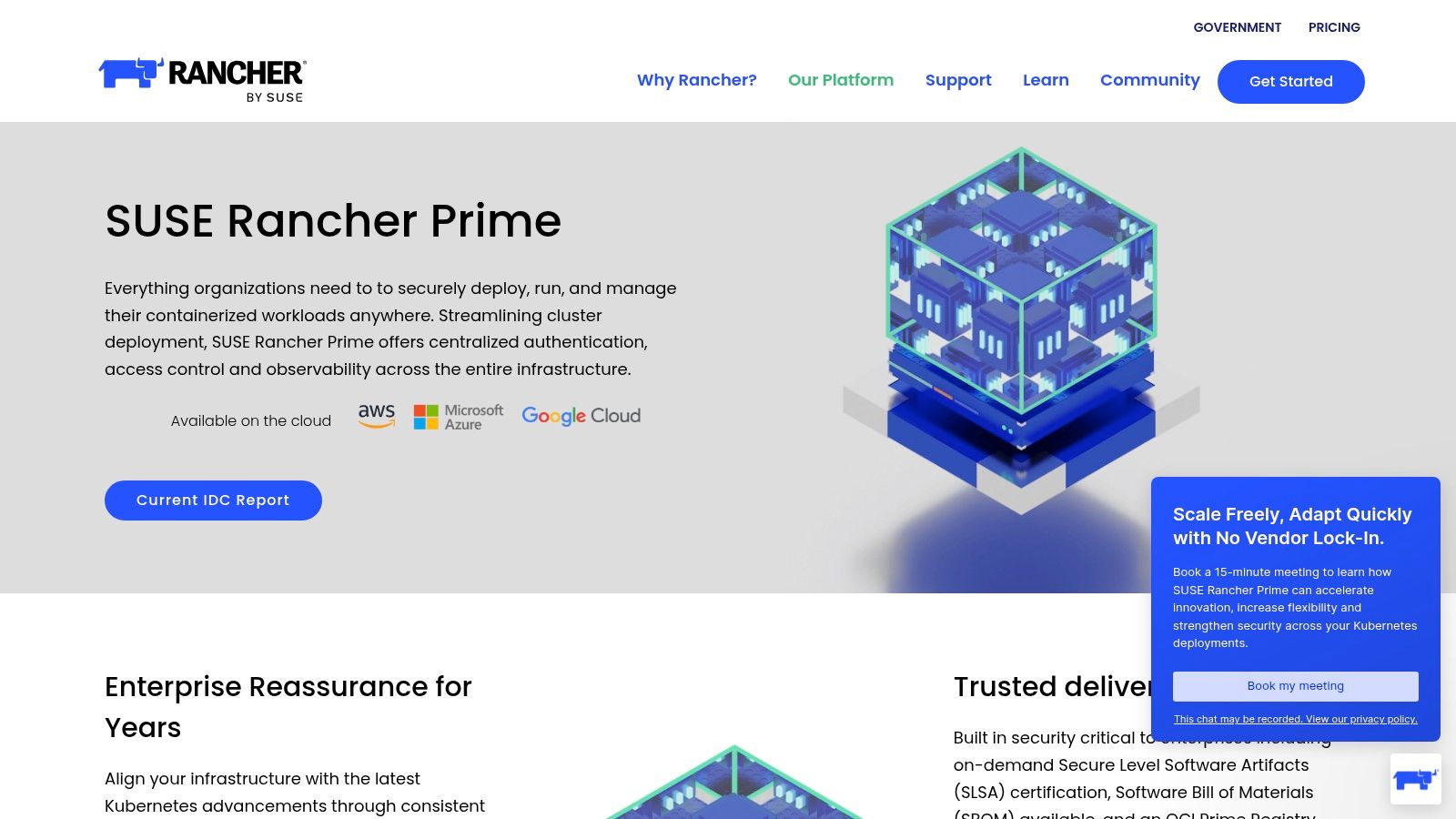
While the core platform is open source, the enterprise-grade version, Rancher Prime, adds crucial features like 24/7 support, a trusted container image registry, and long-term support for specific Kubernetes versions. A key technical advantage is its ability to import and manage existing clusters, providing immediate visibility and control without requiring a rebuild. It also includes integrated tooling for monitoring (Prometheus), logging (Fluentd), and service mesh (Istio). Although the most advanced security and management capabilities are locked behind the paid Rancher Prime subscription, its user-friendly interface and unparalleled flexibility in cluster management offer a compelling solution for organizations seeking to avoid vendor lock-in while standardizing their Kubernetes operations.
- Best For: Organizations managing diverse Kubernetes clusters across hybrid or multi-cloud environments seeking a single API and UI for centralized management and governance.
- Key Feature: Unified management for any certified Kubernetes distribution (EKS, AKS, GKE, RKE, K3s) from a central console, with built-in user authentication and policy enforcement.
- Pricing: Core Rancher is open-source and free. Rancher Prime offers enterprise support and features with a node-based subscription model.
- Website: https://www.rancher.com/products/rancher-platform
6. HashiCorp Nomad
HashiCorp Nomad presents a compelling, simpler alternative for teams who find Kubernetes' operational overhead too steep. It excels as one of the best container orchestration tools by offering workload flexibility, capable of scheduling not just Docker and Podman containers but also VMs (via QEMU), Java applications, and standalone binaries using a unified job specification file. This versatility is delivered through a single, lightweight Go binary that functions as both server and client, dramatically reducing the complexity of deployment and management. It is architected for resilience and scalability, featuring built-in support for multi-region and multi-cloud federations, making it ideal for globally distributed applications.
Nomad’s key technical advantage lies in its seamless integration with other HashiCorp products like Consul for service discovery and Vault for dynamic secrets management, creating a powerful, cohesive platform. Unlike Kubernetes, which requires separate components like etcd, Nomad has a built-in Raft-based consensus protocol, simplifying its operational footprint. While its ecosystem of third-party tools is smaller than Kubernetes', the reduced operational burden and broader workload support make it an excellent choice for organizations prioritizing simplicity and a unified workflow for diverse applications. For teams looking for a managed experience, the HashiCorp Cloud Platform (HCP) offers Nomad as a fully managed service.
- Best For: Teams seeking a simpler, more flexible orchestrator for diverse workloads beyond just containers, including VMs and standalone applications, with a focus on operational simplicity.
- Key Feature: A single, lightweight binary that orchestrates multiple workload types (containers, VMs, executables) and supports multi-region federation out of the box.
- Pricing: Open-source version is free. Enterprise and managed cloud (HCP) versions have custom pricing based on usage and features like advanced governance policies.
- Website: https://www.hashicorp.com/products/nomad
7. Mirantis Kubernetes Engine (MKE)
Mirantis Kubernetes Engine (MKE) is an enterprise-grade container platform designed for organizations with stringent security and compliance requirements. It differentiates itself by offering a hardened, CNCF-validated Kubernetes distribution (based on k0s) that is FIPS 140-2 compliant, making it one of the best container orchestration tools for regulated industries like government, finance, and healthcare. MKE is built for flexibility, allowing deployment on-premises (bare metal, vSphere), in the cloud (AWS, Azure), or on air-gapped networks with consistent operational tooling.
A significant technical advantage is its unique, integrated support for both Kubernetes and Docker Swarm orchestrators within the same cluster, managed by a single control plane. This dual-orchestration capability provides a seamless migration path for teams transitioning from legacy Swarm workloads to Kubernetes without requiring a disruptive lift-and-shift. It also includes Mirantis Secure Registry (MSR) for vulnerability scanning and image policy enforcement. While its powerful enterprise features and dedicated support come with a commercial license, its focus on verifiable security, regulatory adherence, and operational consistency provides critical value for organizations that cannot compromise on compliance.
- Best For: Regulated enterprises (government, finance, defense) requiring a security-hardened, compliant Kubernetes platform with vendor support and a migration path from Docker Swarm.
- Key Feature: Dual orchestration support for both Kubernetes and Docker Swarm, and FIPS 140-2 validated cryptographic modules for enhanced security.
- Pricing: Commercial subscription model based on the number of nodes. Pricing details are available upon request from Mirantis sales.
- Website: https://www.mirantis.com/software/kubernetes-engine
8. VMware Tanzu and vSphere Kubernetes Service
VMware Tanzu provides a Kubernetes runtime and fleet management solution designed for organizations deeply invested in the VMware ecosystem. Its primary strength lies in its native integration with vSphere, allowing IT teams to manage Kubernetes clusters as first-class citizens using the same tools (like vCenter) and skillsets they already use for virtual machines. This creates a unified infrastructure layer where namespaces in Kubernetes can be directly mapped to resource pools in vSphere, enabling consistent operations and governance across both traditional and modern applications within a single, familiar control plane.
The platform is one of the best container orchestration tools for enterprises seeking to modernize their data centers without completely abandoning their existing VMware infrastructure. A key technical differentiator is Tanzu Mission Control, a centralized SaaS management plane that allows operators to enforce security policies (via Cluster API), manage lifecycles, and monitor the health of Kubernetes fleets across on-premises vSphere and public clouds. While its dependency on VMware licensing can be a limitation, its ability to unify VM and container management under one roof offers unparalleled operational efficiency for established VMware shops.
- Best For: Enterprises with significant investments in VMware vSphere looking to run Kubernetes on-premises with unified management and governance for VMs and containers.
- Key Feature: Native integration with vSphere, providing a consistent operational model for both VMs and containers through a centralized management plane, Tanzu Mission Control.
- Pricing: Included as part of VMware Cloud Foundation (VCF) subscriptions; pricing is not publicly listed and is tied to VMware/Broadcom entitlements.
- Website: https://www.vmware.com/products/tanzu.html
9. DigitalOcean Kubernetes (DOKS)
DigitalOcean Kubernetes (DOKS) carves out its niche by offering a simplified and highly cost-predictable managed Kubernetes experience. It’s designed for startups, small to mid-sized businesses, and developers who prioritize ease of use and transparent pricing over the sprawling feature sets of hyperscale cloud providers. The platform abstracts away the control plane management, providing it for free, which significantly lowers the barrier to entry for teams adopting containerization. The developer experience is streamlined through a clean UI, a user-friendly CLI (doctl), and native integrations with DigitalOcean's ecosystem.
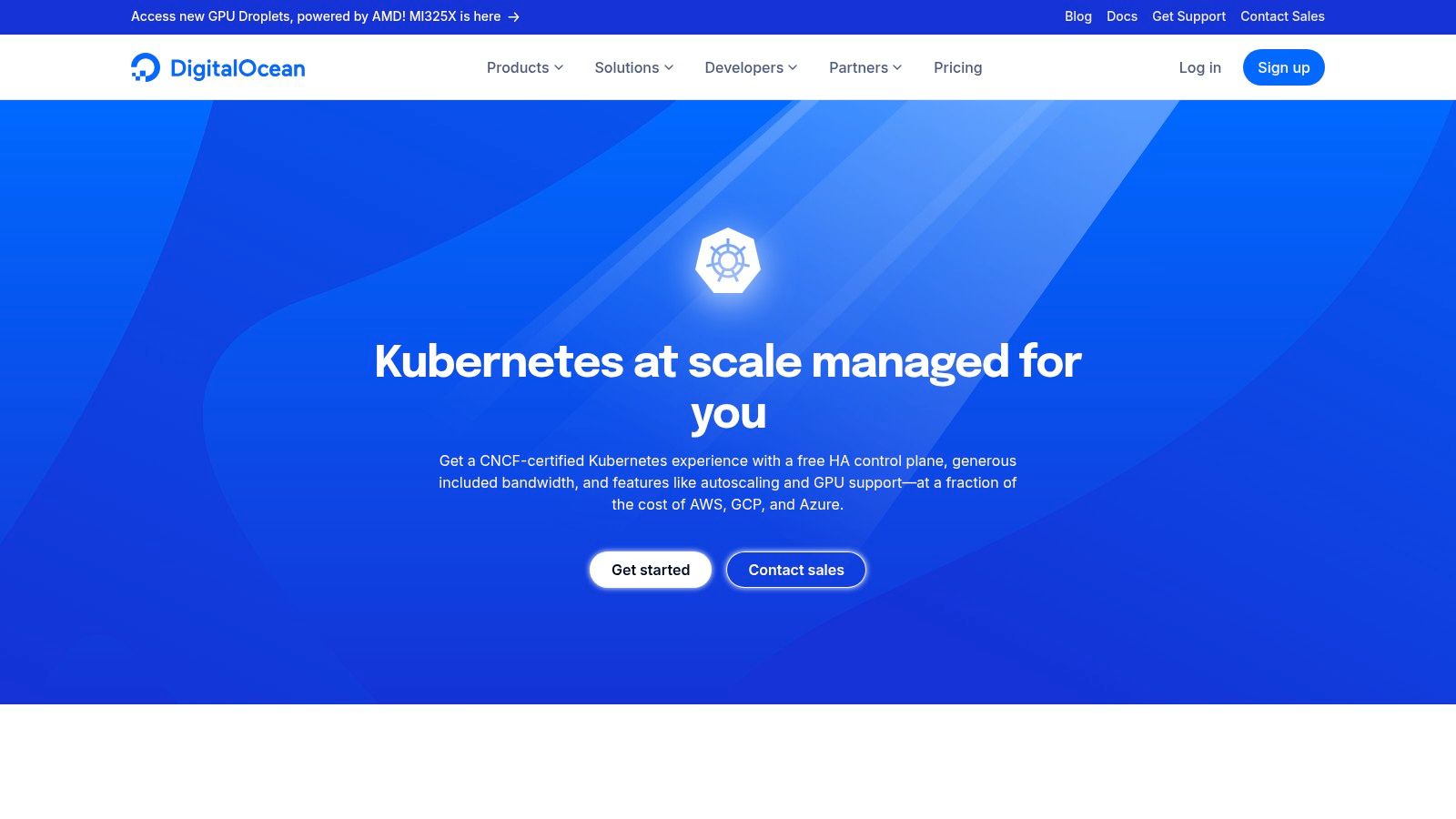
A key technical differentiator for DOKS is its pricing model, which is one of the most transparent among the best container orchestration tools. With a free managed control plane and competitively priced worker nodes (Droplets), teams can easily forecast costs without navigating complex billing calculators. The platform also includes a generous pooled bandwidth allowance, which is a major cost advantage for data-heavy applications. While it may lack some of the advanced enterprise networking (e.g., service mesh integrations) and security features found in AWS or GCP, its tight integration with DigitalOcean’s other products like Volumes Block Storage and Spaces Object Storage makes it a powerful, cohesive platform for running production applications without the overhead.
- Best For: Startups, SMBs, and developer-led teams looking for a simple, affordable, and predictable managed Kubernetes service with a focus on developer experience.
- Key Feature: Free Kubernetes control plane and transparent, low-cost pricing for worker nodes, along with generous pooled bandwidth that reduces egress costs.
- Pricing: The control plane is free (optional HA is an added cost). Worker nodes are billed per second with monthly caps, starting from $12/month per node.
- Website: https://www.digitalocean.com/products/kubernetes
10. Linode Kubernetes Engine (LKE)
Linode Kubernetes Engine (LKE) carves out a niche among the best container orchestration tools by focusing on simplicity, performance, and predictable, cost-effective pricing. It is an ideal managed Kubernetes solution for developers and small-to-medium businesses who need robust container management without the overwhelming complexity and variable costs of hyperscale cloud providers. LKE handles the operational overhead of the Kubernetes control plane—including etcd, the API server, and scheduler—allowing teams to focus on deploying and scaling applications efficiently using standard kubectl commands and manifests.
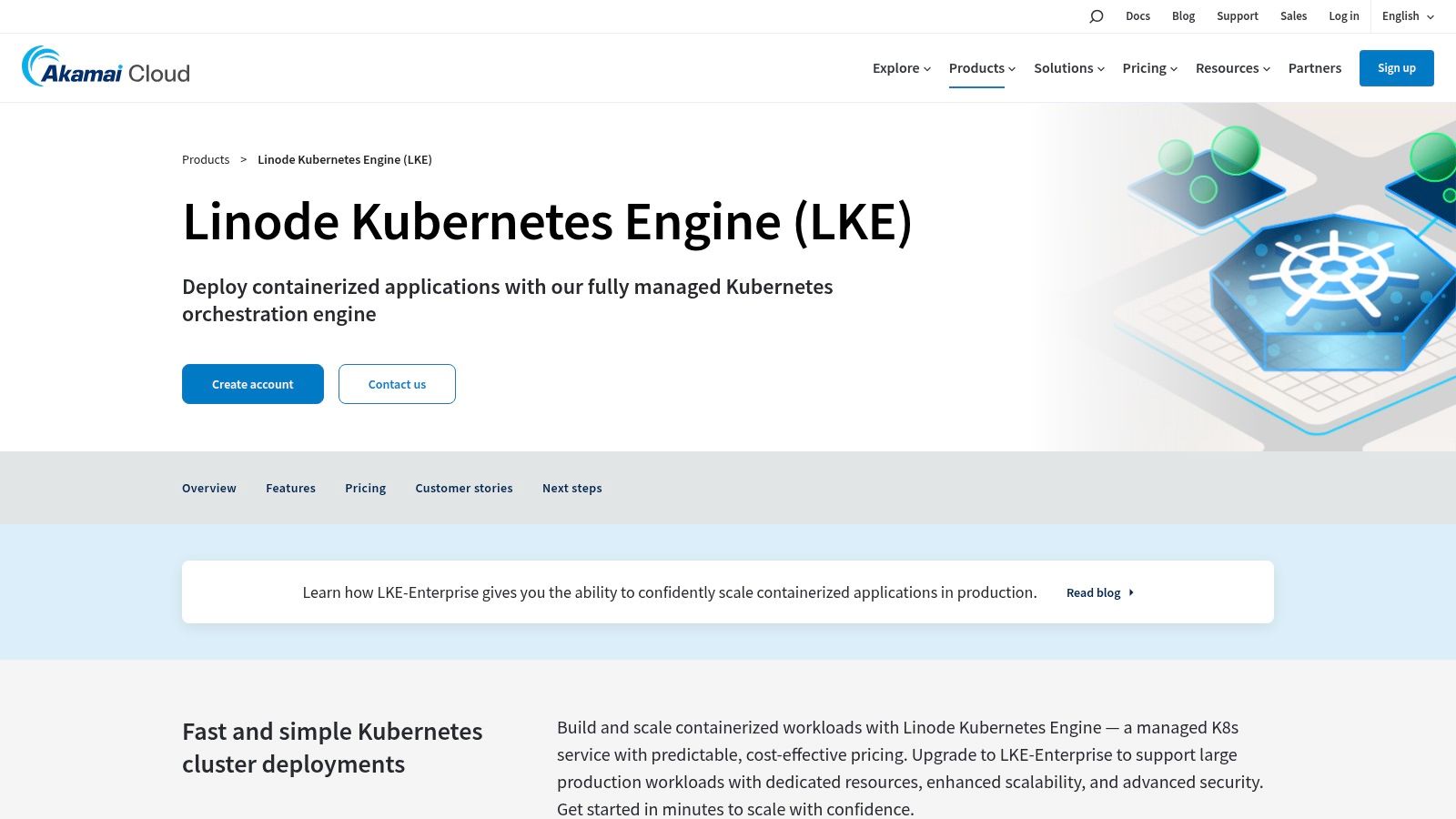
The platform’s key differentiator is its straightforward, value-driven pricing model. The control plane is free, with an optional high-availability (HA) upgrade, and users only pay for worker nodes, storage (Block Storage CSI driver), and NodeBalancers (for LoadBalancer services). Critically, LKE includes a generous bandwidth allowance with very low egress overage fees, making it exceptionally economical for applications with high data transfer requirements. While its managed service catalog is less extensive than AWS or Google Cloud, its intuitive UI, clean API, and focus on core performance make it a powerful choice for running performance-sensitive workloads without financial surprises.
- Best For: Startups, developers, and SMBs seeking a simple, predictable, and high-performance managed Kubernetes service for bandwidth-heavy applications.
- Key Feature: Predictable pricing model with a free control plane, generous network transfer allocation, and extremely low egress costs.
- Pricing: Free control plane (optional HA for $60/month). Users pay for worker nodes, NodeBalancers, and block storage.
- Website: https://www.linode.com/products/kubernetes
11. IBM Cloud Kubernetes Service (IKS)
IBM Cloud Kubernetes Service (IKS) positions itself as a strong contender for enterprises prioritizing security, compliance, and integration with a broader suite of IBM Cloud services, such as Watson AI and IBM Cloud Databases. This managed Kubernetes offering provides a native, upstream Kubernetes experience while handling the operational burden of managing the control plane and master nodes. IBM automates key tasks like security patching, scaling, and recovery, allowing development teams to focus purely on their applications.
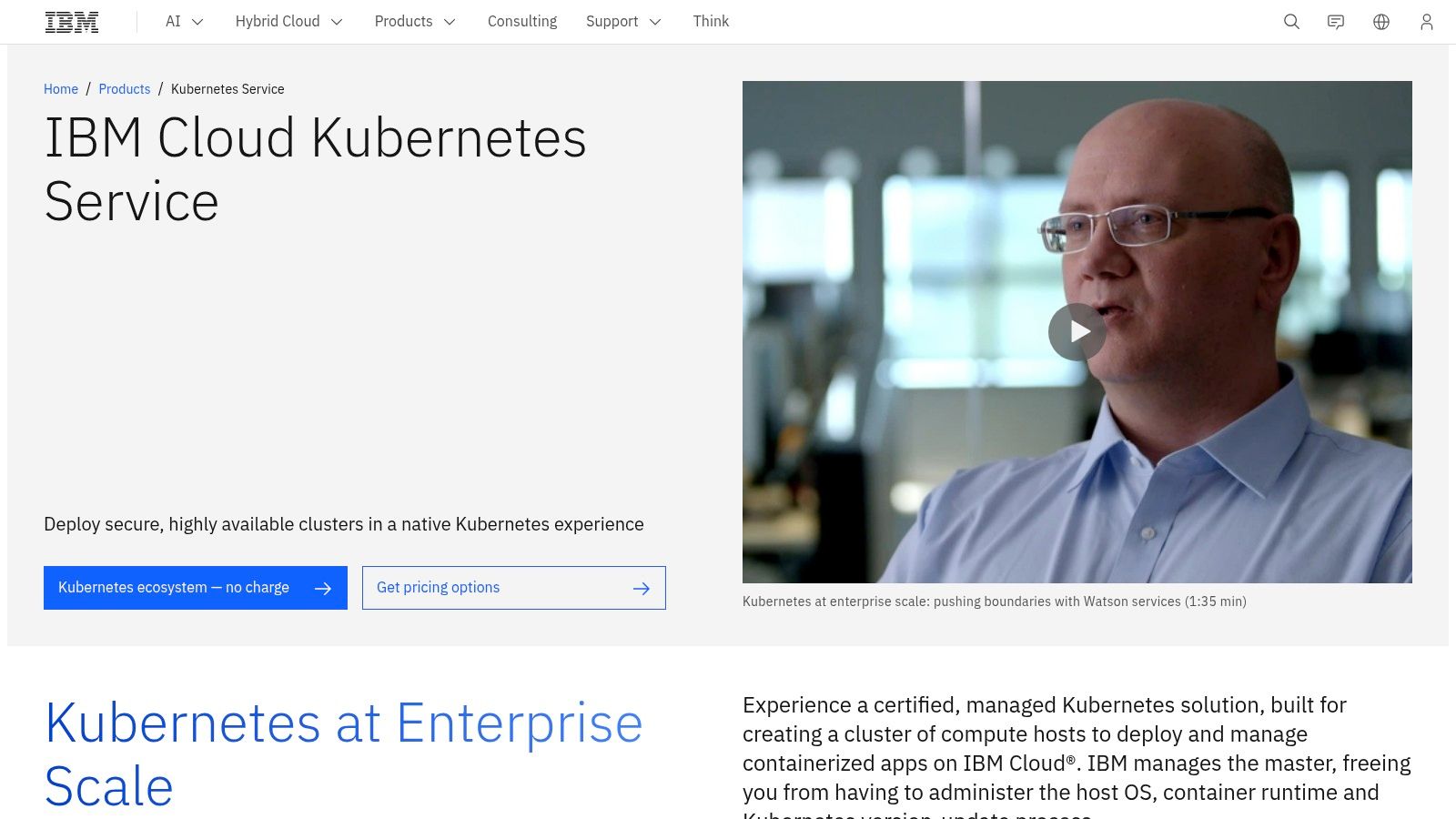
A key technical advantage of IKS is its strong focus on governance and security, offering built-in capabilities for vulnerability scanning with IBM Cloud Container Registry and options for compute isolation with dedicated or bare metal worker nodes. The service is certified for standards like HIPAA and PCI, making it suitable for regulated workloads. While its ecosystem is less extensive than the hyper-scalers, its generous 'Lite' free tier (which provides a single-node, non-HA cluster at no cost for an extended period) and promotional credits offer a frictionless entry point for teams to test and build proofs-of-concept without initial investment. This makes IKS one of the best container orchestration tools for businesses already within the IBM ecosystem or those exploring its specialized AI and data services.
- Best For: Enterprises with stringent security and compliance needs, and teams looking to leverage IBM's Watson AI and data analytics services.
- Key Feature: IBM-managed control plane, built-in security features like vulnerability scanning, and a 'Lite' free tier for easy onboarding and experimentation.
- Pricing: A free cluster tier with a single worker node is available. Paid plans are pay-as-you-go, based on the size and number of worker nodes, plus costs for integrated services.
- Website: https://www.ibm.com/products/kubernetes-service
12. Oracle Container Engine for Kubernetes (OKE)
Oracle Container Engine for Kubernetes (OKE) is a fully managed, scalable, and highly available service for deploying containerized applications on Oracle Cloud Infrastructure (OCI). Its primary differentiator is a unique pricing model that offers a free Kubernetes control plane tier for basic clusters, making it an economically attractive entry point. The service is deeply integrated with the OCI ecosystem, enabling seamless use of OCI Load Balancers for type: LoadBalancer services, Block Volumes for persistent storage via a native CSI plugin, and OCI IAM for mapping users and groups to Kubernetes RBAC.
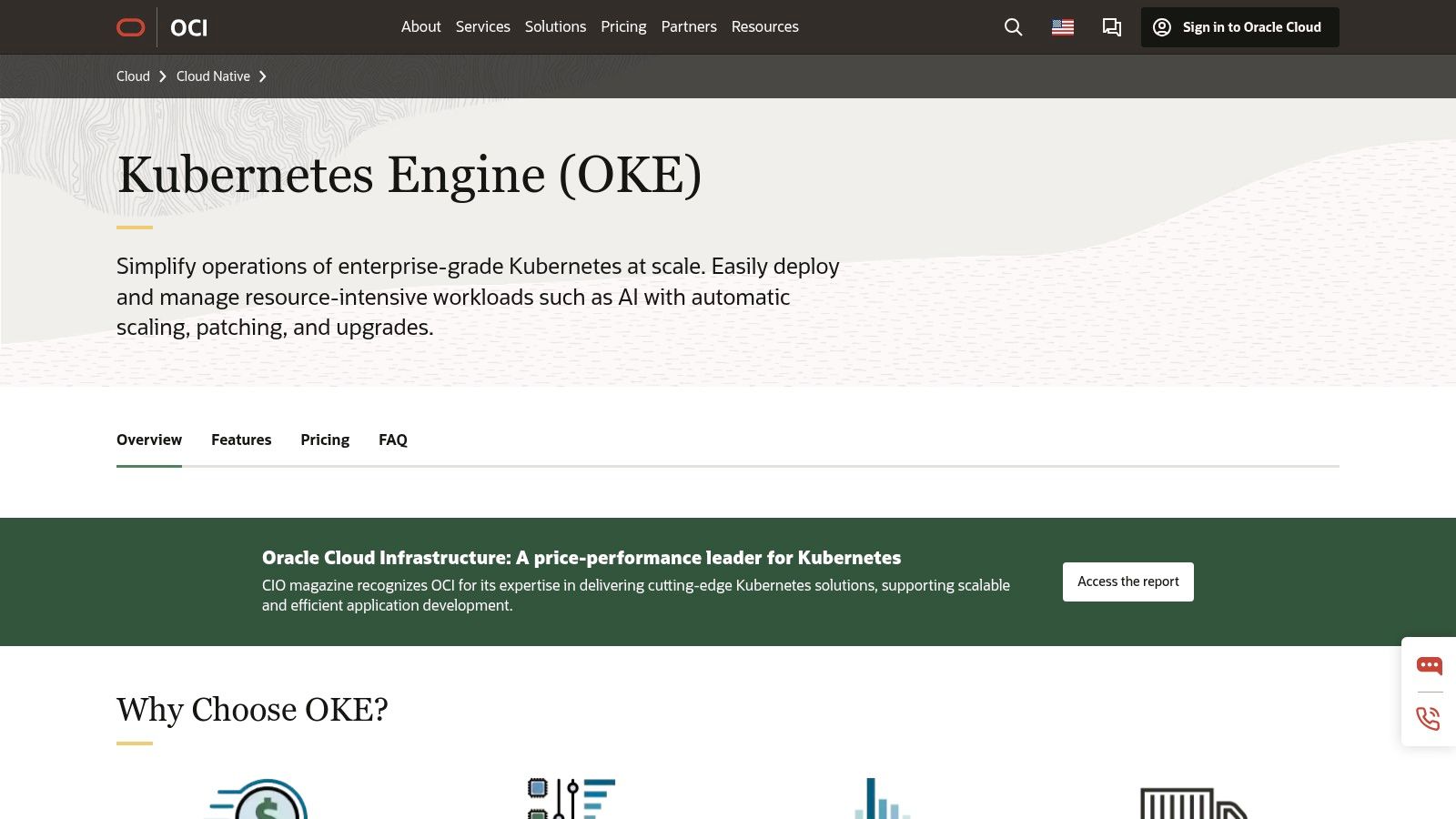
OKE stands out as one of the best container orchestration tools for workloads demanding high performance at a lower cost, as OCI compute instances often provide competitive price-to-performance ratios, especially for bare metal and HPC shapes. For mission-critical applications, users can upgrade to an enhanced cluster type with a financially backed SLA, virtual nodes for serverless Kubernetes, and advanced security add-ons like OCI Network Firewall. While its ecosystem and community are smaller than those of the major hyperscalers, its compelling cost structure and robust performance for CPU- or memory-intensive tasks make it a strong contender for organizations invested in or considering the Oracle Cloud platform.
- Best For: Organizations running performance-sensitive workloads on Oracle Cloud Infrastructure or those seeking a cost-effective managed Kubernetes solution.
- Key Feature: A free "Basic" control plane tier and competitive pricing on high-performance compute resources, including bare metal instances for worker nodes.
- Pricing: The Basic control plane is free; an enhanced, SLA-backed control plane is available at $0.10 per hour per cluster. Users pay for worker nodes and other OCI resources.
- Website: https://www.oracle.com/cloud/cloud-native/kubernetes-engine
Top 12 Container Orchestration Tools Comparison
| Solution | Core Features | User Experience & Quality | Value Proposition | Target Audience | Price Points |
|---|---|---|---|---|---|
| Amazon EKS – AWS | Managed control plane, AWS integrations, IRSA, VPC CNI | Strong AWS ecosystem integration, mature security | Broad service integrations, reliable | Startups to enterprises | Complex cost model, variable |
| Google Kubernetes Engine (GKE) | Autopilot mode, fleet management, advanced autoscaling, SLAs | Highest level of operational automation | Best-in-class autoscaling & SLAs | Teams seeking automation | Regional fees, free tier |
| Azure Kubernetes Service (AKS) | Windows support, Azure AD integration, multi-tier pricing | Flexible tiers, enterprise-grade identity | Strong Windows container support | Enterprise hybrid users | Tiered pricing, free & paid |
| Red Hat OpenShift | Multi-cloud, built-in CI/CD, OperatorHub, hardened security | Opinionated stack, strong multi-year support | End-to-end enterprise Kubernetes | Large enterprises | Commercial license required |
| SUSE Rancher (Rancher Prime) | Multi-cluster mgmt, multi-distro support, centralized auth | Strong multi-cluster UX, curated apps | Broad distro support & enterprise SLA | Enterprises managing fleets | Node-based pricing, subscription |
| HashiCorp Nomad | Lightweight, multi-region, multi-workload (VM, .jar, exe) | Simple ops, supports diverse workloads | Lower complexity alternative | Users needing diverse workloads | Open-source & managed service |
| Mirantis Kubernetes Engine | Security/hardening (FIPS), Docker Swarm support, compliance | Security-focused, vendor SLAs | Regulatory compliance & hardened security | Regulated industries | Commercial licenses |
| VMware Tanzu & vSphere K8s | Multi-cluster mgmt, vSphere integration, unified governance | Native VMware integration | VMware ecosystem customers | VMware users & enterprises | Included in VCF subscriptions |
| DigitalOcean Kubernetes (DOKS) | Free control plane, low node pricing, pooled bandwidth | Simple UX, cost transparency | Cost-predictable for SMBs/startups | SMBs, startups | Low, transparent pricing |
| Linode Kubernetes Engine (LKE) | Free control plane, pay for worker nodes, low egress fees | Simple setup, good bandwidth value | Cost-conscious workloads | Cost-sensitive users | Predictable, pay for usage |
| IBM Cloud Kubernetes Service | Managed masters, vulnerability scanning, free tier & credits, compliance | Enterprise SLAs, easy testing | Enterprise-grade security & integration | Enterprises & IBM users | Complex pricing |
| Oracle Container Engine (OKE) | Basic free control plane, OCI integrations, paid SLA tier, bare metal nodes | Competitive on CPU/memory workloads | Low-cost control plane, OCI integration | Cost-conscious enterprises | Free basic, paid advanced tiers |
Accelerate Your Orchestration Strategy with Expert Guidance
Navigating the landscape of container orchestration platforms can feel like a formidable task. We've explored a wide spectrum of the best container orchestration tools, from the hyperscaler-managed dominance of AWS EKS, Google GKE, and Azure AKS to the enterprise-grade control offered by Red Hat OpenShift and VMware Tanzu. We also examined the unique, flexible approaches of HashiCorp Nomad and the platform-agnostic management capabilities of SUSE Rancher, alongside strong contenders like DigitalOcean Kubernetes and Mirantis Kubernetes Engine.
The central takeaway is clear: there is no single "best" tool, only the right tool for your specific technical and business context. The ideal choice hinges on a strategic evaluation of your existing infrastructure, team expertise, scalability requirements, and budget constraints. Your decision is not merely a technical one; it's a foundational choice that will shape your organization's operational efficiency, development velocity, and long-term cloud strategy.
Finalizing Your Decision: A Strategic Checklist
Before you commit to a platform, revisit these critical decision points. This framework will help you distill the options into a clear path forward.
- Evaluate Your Team's Skillset: Do you have deep Kubernetes expertise in-house, or do you need a managed service that abstracts away the complexity of the control plane? Platforms like GKE Autopilot and EKS with Fargate excel here, while a self-managed OpenShift or Rancher deployment demands more specialized knowledge in areas like etcd management and networking plugins.
- Assess Your Cloud and Infrastructure Strategy: Are you standardized on a single cloud provider, or are you pursuing a multi-cloud or hybrid model? Tools like SUSE Rancher and Red Hat OpenShift are purpose-built for this complexity. If you're all-in on AWS, EKS provides unparalleled native integration with services like IAM and VPC.
- Analyze Your Workload Requirements: Are you running standard stateless microservices, or do you have complex stateful workloads (e.g., databases), batch jobs, or even non-containerized tasks? HashiCorp Nomad's flexibility to orchestrate diverse workload types might be a significant advantage over Kubernetes-centric platforms.
- Consider Total Cost of Ownership (TCO): Look beyond the sticker price of the control plane. Factor in the operational overhead, the cost of specialized talent, egress data transfer costs, and the potential for vendor lock-in. A managed service might seem more expensive initially but could drastically reduce your long-term TCO by offloading management responsibilities.
Implementing Your Chosen Tool for Success
Selecting your tool is only the first step. Successful implementation requires careful planning, focusing on automation, security, and observability from day one. Regardless of which of the best container orchestration tools you choose, prioritize building a robust GitOps-based CI/CD pipeline using tools like ArgoCD or Flux. Implement security policies-as-code with tools like OPA Gatekeeper or Kyverno to enforce guardrails, and establish comprehensive monitoring with platforms like Prometheus and Grafana to gain deep visibility into cluster and application health.
Ultimately, container orchestration is about empowering your engineering teams to build, ship, and run applications faster and more reliably. The right platform will act as a force multiplier, unlocking new levels of agility and scale. By aligning your choice with your strategic goals and investing in a thoughtful implementation, you can build a resilient, future-proof foundation for your applications.
Choosing the right tool is critical, but expert implementation is what guarantees success. If your team needs to scale its DevOps capabilities or requires specialized expertise to manage complex orchestration environments, OpsMoon provides on-demand access to elite, pre-vetted freelance DevOps, SRE, and Platform Engineers. OpsMoon connects you with the talent you need to accelerate your projects and master your chosen container orchestration platform.
